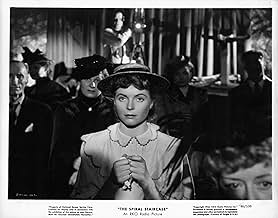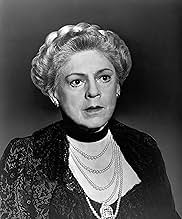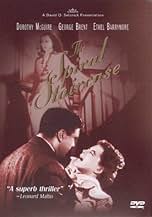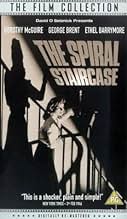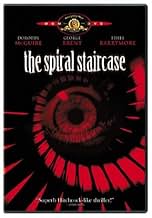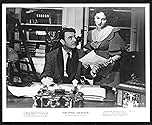IMDb-BEWERTUNG
7,3/10
12.038
IHRE BEWERTUNG
Im Jahr 1916 hat es ein zwielichtiger Serienmörder auf Frauen mit "Gebrechen" abgesehen; eines Nachts, während eines Gewitters, fühlt sich die stumme Helen bedroht.Im Jahr 1916 hat es ein zwielichtiger Serienmörder auf Frauen mit "Gebrechen" abgesehen; eines Nachts, während eines Gewitters, fühlt sich die stumme Helen bedroht.Im Jahr 1916 hat es ein zwielichtiger Serienmörder auf Frauen mit "Gebrechen" abgesehen; eines Nachts, während eines Gewitters, fühlt sich die stumme Helen bedroht.
- Regie
- Drehbuch
- Hauptbesetzung
- Für 1 Oscar nominiert
- 2 Gewinne & 2 Nominierungen insgesamt
Erville Alderson
- Dr. Harvey
- (Nicht genannt)
Ellen Corby
- Neighbour
- (Nicht genannt)
Myrna Dell
- Murder Victim
- (Nicht genannt)
George Holmes
- The Killer's 'Shadow'
- (Nicht genannt)
Stanley Price
- Starry-eyed Man
- (Nicht genannt)
Robert Siodmak
- The Killer's 'Eye'
- (Nicht genannt)
Richard Tyler
- Freddy
- (Nicht genannt)
Charles Wagenheim
- Desk Clerk
- (Nicht genannt)
Empfohlene Bewertungen
Being one of the last truly great thriller/mystery classics I still had lingering on my must-see list; I cherished big expectations for "The Spiral Staircase". Perhaps even a little TOO big
Don't get me wrong, it's a fantastic film and a bona fide genre masterpiece, but somehow I expected even more suspense and moodiness! Let me just get out of my system that certain sequences inside the old dark house were a bit tedious and overdone. But hey, who's complaining, since the full rest of the film is pure perfection in terms of beauty, elegance, atmosphere and scenery. It's rather intriguing how certain films, like "Freaks" or "Peeping Tom" to name just two, caused so much controversy and scandal while "The Spiral Staircase" is widely considered as an untouchable landmark even though it features similar prohibited themes like voyeurism and murder victims with a disability. The opening sequence is almost too brilliant for words. A medium sized crowed gathers in a small theater for a silent movie screening while, on the floor above them, a crippled girl prepares herself to go to sleep. The utmost evil glazing eye watches her from inside the wardrobe and strikes exactly when she lifts the gown over her head. You can't get any more expressionistic than that. After that, "The Spiral Staircase" establishes itself as the sheer archetype of old dark house thrillers. The beautiful but mute Helen is a social worker in the secluded mansion of the ailing Mrs. Warren. A heavy thunderstorm rages outside, Mrs. Warren son and stepson argue over their life styles (and the lovely secretary Blanche) and the rest of the household staff either turns to alcohol or complains about the stubborn matriarch. Both Mrs. Warren and her doctor urge Helen to leave town. Could it be the maniacal killer is inside the house? This film is a rarity. Even though it doesn't require an Einstein brain to figure out the killer's identity, you honestly don't care that much and remain glued to the screen to admire how the Gothic atmosphere unfolds further. Director Robert Siodmak – a German immigrant in America following WWII – truly masters the cinematography and Victorian set pieces. He also manages to include the thunderstorm as an extra – and essential – supportive character. Speaking of the cast, I dare you to name a so-called 'damsel in distress' more amiable than Dorothy McGuire's Helen. She's a vulnerable angel, targeted by a frustrated and obsessive madman on a mission to rid the world of imperfection. Especially the women impress in "The Spiral Staircase" as I simply must also mention Ethel Barrymore as Mrs. Warren (nominated for an Oscar, even) and Elsa "Bride of Frankenstein" Lanchester as the maid with a taste for brandy.
THE SPIRAL STAIRCASE is one of the best known in the "old dark house" genre. These films typically feature a disparate group of characters who inevitably find themselves alone and trapped within a huge, rambling and spooky old house on the night of a storm, with a killer amongst them. What's notable about this outing is just how stylish it is: the story is nothing special, but the style makes it.
The story features a black-gloved killer (complete with POV shots) who hides in wardrobes and stalks his young, female victims and strangles them. In one of the movie's most infamous shots, the viewer sees a victim from the killer's point of view, and she's missing her mouth; symptomatic of his disturbed mind, and highly eerie with it. The whodunit aspect of the storyline is played up strongly, with some red herrings thrown into the mix, although it's pretty easy for a modern viewer to guess the identity of the murderer.
THE SPIRAL STAIRCASE features some decent performances, particularly from Dorothy McGuire, playing (unusually) a leading role as a mute. That the viewer becomes accustomed to her muteness and, eventually, even forgets about it is testament to her performance. Elsewhere in the cast, there's a barnstorming turn from grand old dame Ethel Barrymore who rules the roost from her deathbed, and a nicely comic performance from the BRIDE OF FRANKENSTEIN herself, Elsa Lanchester, as a drunk cook.
In the end, the film works because of the visual flourishes. As in a film noir, there's a lot of creeping about in the shadows, and silhouettes of various things and people play a big part. The emphasis on a deranged killer is a neat precursor to the later gialli and slasher films of the '70s and '80s, and there's little padding on the bare bones of the narrative. It's a good 'un.
The story features a black-gloved killer (complete with POV shots) who hides in wardrobes and stalks his young, female victims and strangles them. In one of the movie's most infamous shots, the viewer sees a victim from the killer's point of view, and she's missing her mouth; symptomatic of his disturbed mind, and highly eerie with it. The whodunit aspect of the storyline is played up strongly, with some red herrings thrown into the mix, although it's pretty easy for a modern viewer to guess the identity of the murderer.
THE SPIRAL STAIRCASE features some decent performances, particularly from Dorothy McGuire, playing (unusually) a leading role as a mute. That the viewer becomes accustomed to her muteness and, eventually, even forgets about it is testament to her performance. Elsewhere in the cast, there's a barnstorming turn from grand old dame Ethel Barrymore who rules the roost from her deathbed, and a nicely comic performance from the BRIDE OF FRANKENSTEIN herself, Elsa Lanchester, as a drunk cook.
In the end, the film works because of the visual flourishes. As in a film noir, there's a lot of creeping about in the shadows, and silhouettes of various things and people play a big part. The emphasis on a deranged killer is a neat precursor to the later gialli and slasher films of the '70s and '80s, and there's little padding on the bare bones of the narrative. It's a good 'un.
This was an excellent suspense film with outstanding cinematography and interesting characters played by a strong cast.
There are lots of complimentary adjectives in the above sentence but the film deserves it, particularly the photography (see this on DVD). The lighting is as good as anything I've ever seen in film noir (this is not a film noir, as one reviewer correctly points out). In fact, outside of David Lean's "Oliver Twist, " this may be the best-looking black-and-white film I've seen. A good part of the visual treat is viewing the fantastic Victorian house where most of the action takes place.
The lead character, played beautifully by Dorothy McGuire, is one the viewer cares about which helps get one involved in the story. All the other characters are fun to watch, and are detailed here in other reviews. I go along with most in saying Ethel Barrymore was the most likable.
There are a few holes in the storyline, to be sure, but one doesn't care since the film movies rapidly, the story keeps you so involved and the visuals and audio are so interesting. This latter also features the longest thunderstorm on record!
There are lots of complimentary adjectives in the above sentence but the film deserves it, particularly the photography (see this on DVD). The lighting is as good as anything I've ever seen in film noir (this is not a film noir, as one reviewer correctly points out). In fact, outside of David Lean's "Oliver Twist, " this may be the best-looking black-and-white film I've seen. A good part of the visual treat is viewing the fantastic Victorian house where most of the action takes place.
The lead character, played beautifully by Dorothy McGuire, is one the viewer cares about which helps get one involved in the story. All the other characters are fun to watch, and are detailed here in other reviews. I go along with most in saying Ethel Barrymore was the most likable.
There are a few holes in the storyline, to be sure, but one doesn't care since the film movies rapidly, the story keeps you so involved and the visuals and audio are so interesting. This latter also features the longest thunderstorm on record!
This is a terrific thriller, made just the way that thrillers should be done, with nicely crafted tension, atmospheric setting, and plenty of strange and mysterious characters. Adding in the excellent leading performance by Dorothy McGuire makes it a top-notch picture.
From the very beginning, the suspense begins to build, while at the same time McGuire's character Helen immediately attracts and holds the audience's concern and sympathy. The combination works very well, and while you're never sure what else is going on, or which of the other characters can be trusted, you know that Helen is in danger and that you care about her.
The rest of the cast are all nicely matched with their characters, and do a fine job of bringing them to life. Some of the plot developments probably would prove somewhat implausible if analyzed carefully, but the story and atmosphere are crafted so effectively that you never notice while watching.
Anyone who enjoys classic thrillers should make sure to see "The Spiral Staircase".
From the very beginning, the suspense begins to build, while at the same time McGuire's character Helen immediately attracts and holds the audience's concern and sympathy. The combination works very well, and while you're never sure what else is going on, or which of the other characters can be trusted, you know that Helen is in danger and that you care about her.
The rest of the cast are all nicely matched with their characters, and do a fine job of bringing them to life. Some of the plot developments probably would prove somewhat implausible if analyzed carefully, but the story and atmosphere are crafted so effectively that you never notice while watching.
Anyone who enjoys classic thrillers should make sure to see "The Spiral Staircase".
It's 1916 and a rash of women being killed who are 'imperfect' in the eyes of the killer whomever it is have both Dr. Kent Smith and bedridden dowager Ethel Barrymore concerned for the life of Dorothy McGuire, a beautiful, but mute servant girl in her house.
There's not much mystery to this film, it's not hard to guess the identity of the perpetrator, given the limited number in the cast. But The Spiral Staircase is one of the most atmospheric films ever done. Director Robert Siodmark made terrific use of the Victorian era set of the Warren house where 90% of the film is done. The centerpiece of course being The Spiral Staircase.
Two years before a deaf mute act won Jane Wyman an Academy Award, a lot of people, me included, felt Dorothy McGuire should have at least gotten a nomination for her role. She conveys so much in her portrayal, the meekness of her character and the gradual overwhelming fear that takes over her as she senses danger. Worse even when she fixes on the wrong individual as her menace.
Ethel Barrymore got an Academy Award nomination for Best Supporting Actress as the crotchety old woman who was in McGuire's keeping. But Ethel had won the same Oscar back in 1944 for None But The Lonely Heart. She lost in the finals to Anne Baxter for The Razor's Edge.
George Brent, Gordon Oliver, Rhys Williams, Rhonda Fleming, and Elsa Lanchester round out a good cast in one of the best atmospheric thrillers ever put on film.
There's not much mystery to this film, it's not hard to guess the identity of the perpetrator, given the limited number in the cast. But The Spiral Staircase is one of the most atmospheric films ever done. Director Robert Siodmark made terrific use of the Victorian era set of the Warren house where 90% of the film is done. The centerpiece of course being The Spiral Staircase.
Two years before a deaf mute act won Jane Wyman an Academy Award, a lot of people, me included, felt Dorothy McGuire should have at least gotten a nomination for her role. She conveys so much in her portrayal, the meekness of her character and the gradual overwhelming fear that takes over her as she senses danger. Worse even when she fixes on the wrong individual as her menace.
Ethel Barrymore got an Academy Award nomination for Best Supporting Actress as the crotchety old woman who was in McGuire's keeping. But Ethel had won the same Oscar back in 1944 for None But The Lonely Heart. She lost in the finals to Anne Baxter for The Razor's Edge.
George Brent, Gordon Oliver, Rhys Williams, Rhonda Fleming, and Elsa Lanchester round out a good cast in one of the best atmospheric thrillers ever put on film.
Wusstest du schon
- WissenswertesRobert Siodmak: the close-ups of the killer's eyes and hands.
- PatzerWhen Helen first walks up the main staircase, she pauses to look at herself in the mirror. In the next shot as the camera slowly rolls backwards, she is still looking in the mirror, but there is no reflection of herself (just a painting designed to look like mirror).
- Alternative VersionenThe MGM DVD has the opening and closing MGM logos in addition blacking out the RKO Pictures logo.
- VerbindungenFeatured in Stairs (1986)
- SoundtracksWaltz Op. 34 No. 2 in A minor
(uncredited)
Composed by Frédéric Chopin
[The first half of the piano accompaniment to the silent movie]
Top-Auswahl
Melde dich zum Bewerten an und greife auf die Watchlist für personalisierte Empfehlungen zu.
Details
- Laufzeit
- 1 Std. 23 Min.(83 min)
- Farbe
- Seitenverhältnis
- 1.37 : 1
Zu dieser Seite beitragen
Bearbeitung vorschlagen oder fehlenden Inhalt hinzufügen



